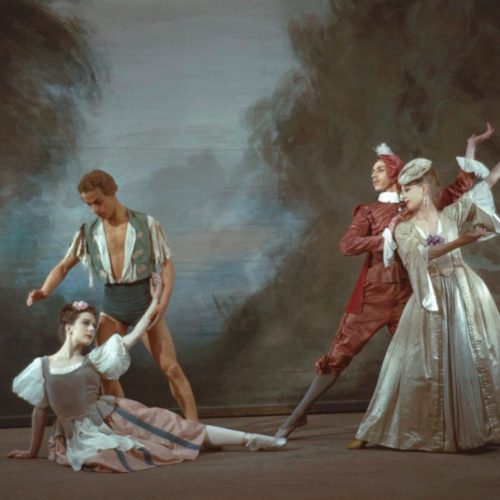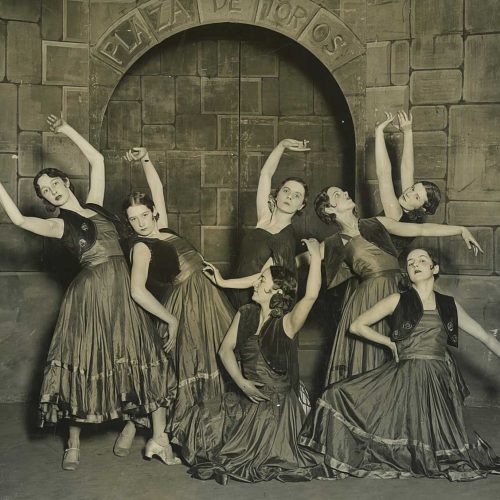Leo Kersley
In this podcast, the dancer and teacher Leo Kersley discusses his formative years in London in the 1930s and the many different companies he eventually worked with during the Second World War, including a stint at the Windmill Theatre. Talking to Patricia Linton, director of Voices of British Ballet, he also mentions how, as a conscientious objector, he was briefly imprisoned at the start of the war. The interview is introduced by Jane Pritchard.
First published: October 14, 2025
Biography
Leo Kersley was born in poverty in Hertfordshire in 1920. His family having moved to London, he studied dance under a number of teachers, including Marie Rambert at the Mercury Theatre in 1934, dancing professionally from time to time. He was a soloist in Ballet Rambert from 1936 to 1939, and in 1939 worked for the Ballet Trois Arts.
On the outbreak of World War Two in 1939, he registered as a conscientious objector and was briefly imprisoned. On his release, during 1940 and 1941 he combined his work in a hospital with dancing for Rambert in the evenings alongside his first wife, Celia Franca. He was a member of Sadler’s Wells Ballet from 1941-1942, and then the International Ballet. He was a member of the Anglo-Polish Ballet from 1942-1943. From 1945 until 1951 Kersley performed with Sadler’s Wells Theatre Ballet.
In 1952, Kersley went to teach in Denver, Colorado, and in 1953 to Rotterdam in The Netherlands. Whilst there he danced with a number of companies but returned to England in 1959 to set up his own school in Harlow, which he ran with his second wife, Janet Sinclair. With Sinclair, who died in 1999, he published the well-regarded Dictionary of Ballet Terms in 1952.
Transcript
in conversation with Patricia Linton
Leo Kersley: When we came to London in 1929 [it was] because of the Depression. Father, he thought, now we’ve got to live in one room, we’ve got to make this place interesting for him. So, he took me to the Science Museum, and he was always making London attractive. And one of the things that was attractive was that Lilian Baylis was now going to have a people’s theatre on the north side of the Thames: Sadlers Wells. So, for the first season of Sadlers Wells, I got taken to shows there and father had me doing all sorts of things. So, as I was reconciled to London, really.
Patricia Linton: So, he had a big interest in the theatre. Did your mother accompany you?
Leo Kersley: Oh, yes.
Patricia Linton: She loved the theatre as much as your father?
Leo Kersley: Oh yes. And then we moved into the slums near Sadler’s Wells. Then I started going on my own, I think in 1932. I’ve got a date.
Patricia Linton: Was this to the ballet or opera?
Leo Kersley: No, it was… I’d heard that if I went to the opera on the Saturday matinée, there would be a devil dressed as the devil, always was in red from toes to top with a red thing.
Patricia Linton: And this caught your imagination?
Leo Kersley: And I made marionettes, and I was wanting to make a devil. So, of course, I had to go and see the devil. I went down and they started off first before to go in five minutes. I realised I knew all the tunes, so I became an opera maniac and I still am.
Patricia Linton: Did you have any thoughts at that point that you needed to start training [in ballet]?
Leo Kersley: It was simply in the programme in those days. There was always an advert about the Sadler’s Wells Ballet School. So, obviously we were going to try the ballet school. And, of course, when we wrote and got a letter from Evelyn Marsh Williams saying, unfortunately, we have no facilities for boys, there was doom and gloom like you can’t imagine. You know, Fred Ashton was roped in because he was a friend of a friend of the family. What do we do? You see? And Fred Ashton, oh, God, you don’t know how lucky you are, because at this time he was the leading man of Ballet Rambert. This was before he went to the Wells, you see… the place to go, is Rambert? So, I went off to Rambert.
Patricia Linton: Leo, after you’d left Rambert, where did you go? Immediately to Ballet Trois Arts?
Leo Kersley: No, I was chucked out of Rambert because I was rehearsing with the Russian ballet, to go with the de Basil [Colonel de Basil’s Ballet Russe] company. And I was going and most of the company went. But by that time the war had been declared, so I couldn’t get out of the country. So, John Regan started a company in 1939 called Ballet Trois Arts, and so we were performing, oh only a week or two after the war was declared.
Patricia Linton: Why did you decide to leave Rambert? What made you want to go to the Russian ballet?
Leo Kersley: Every, everybody went right. They had to… it’s something you had to do if you had the chance… there was no such thing as British ballet. Right, in 1939. I mean, it just didn’t exist.
Patricia Linton: Even though you’d done all this work with Antony Tudor and achieved so much by that time, you still didn’t feel you were a fully-fledged dancer unless you had this experience with the Russian [ballet]?
Leo Kersley: You weren’t a dancer if you weren’t in the Russian ballet.
Patricia Linton: You’ve explained to me how you came into the position of joining John Regan. Could you explain a little bit about where they danced and their repertoire?
Leo Kersley: Well, when the war came, they shut all the theatres, but John Regan was into doing something, so just carried on rehearsing and co-opted people when somebody disappeared and he co-opted Celia [Franca] and I. So, I think it was the first dance performance, perhaps not the first, because after the declaration of war at [The] Collins’ Theatre [also known as The Collins’ Music Hall]…
Patricia Linton: Was it at the Lyric Hammersmith?
Leo Kersley: No, it was at Collins’ Theatre [in Islington], and then we went to the Lyric Theatre Hammersmith next.
Patricia Linton: I think it was only him and the Windmill [Theatre] that kept going.
Leo Kersley: Oh, yeah, [The] Windmill was a lovely place because… Keith Lester used to do his ballets there, and the thing was that if you were resting, you’d say, ‘oh, my show or whatever is finishing next month’. All right. So, he’d make a part for you in the ballet among all the nudes in the next show, because they ran for a month at a time and it was home from home and all sorts of respectable people used to dance [at] The Windmill, you see. And it was lovely to go up in the room up in the roof where the canteen was and sit with all the girls, you’d see even more of than before! And we changed the programme twice a week.
Patricia Linton: Yes. Do you remember a ballet called Perseus?
Leo Kersley: Of course.
Patricia Linton: This is one of John Regan’s?
Leo Kersley: Yeah, but I had… that was my first real leading part, you know, created for me. And it was a fabulous part with wonderful music by the composer Stanley Bate and a wonderful orchestra. Oh, it was fabulous. And it turned out to be a smash hit all season. So, I started having people coming to see me and collect my autograph. And that was 1939. Yeah. Yeah.
Patricia Linton: And was he a good choreographer? John?
Leo Kersley: I don’t know. He was very clever, very bright. He was a mathematician who worked for [John] Maynard Keynes at one time. Then the designer he got was a bad surrealist. So, Tony De Lorenzo said, ‘We have to have a surrealist ballet’, you see, and he got Elisabeth Lutyens, who is an outrageously modern composer to do the score, you see, for this ballet called Midas. She turned up with the score, you see, and it was presented to Regan, and he just looked at it. And, bright as he was, he thought, ‘Christ, this surrealist, score by this crazy, mad woman’, you see. So, he looked at it and Celia was there, and she said, ‘Oh, it’s not that difficult, you see’ and sat down and started arranging [it] for piano forte. So, he said, you can do a ballet can’t you.
Patricia Linton: So, Celia was very musical?
Leo Kersley: Oh, she was a pianist.
Patricia Linton: So, you stayed with John just about a year?
Leo Kersley: Oh, no, it was from September. We appeared at [The] Collins’ Theatre until January [1940], and in January we were tempted back to the Rambert. That was lovely. Rambert was away, you see, so Walter [Gore] employed us, and we got on very well, you see, with Walter. But Rambert was away in Newbury running the school.
Patricia Linton: The school went up to Newbury. That’s right.
Leo Kersley: And we toured around with Rambert there from 1940, Jan until 1941.
Patricia Linton: And this was the repertoire that you were used to?
Leo Kersley: Yeah, it was lovely.
Patricia Linton: And then something made you decide to leave?
Leo Kersley: And then at the beginning of [19]41, Mona Inglesby started a company, you see, and the salary was the Equity minimum salary – rude word, Equity!
Patricia Linton: Was Equity working then?
Leo Kersley: Oh yeah, yeah. I was in the doghouse because I was a member. But yeah, it was a quid [pound] a week, which was a fortune because we were getting less at that time than a pound a week at Rambert, and the Vic-Wells Ballet was getting about a pound a week. And so, of course, I was tempted, you know, to go there for eight quid a week and, of course, Celia too. So that was lovely.
Patricia Linton: And on eight pounds a week each. Could you afford quite reasonable lodgings?
Leo Kersley: Oh, it was fabulous. Sixteen pounds a week between two. You can’t imagine! So, when we went to Cambridge or Edinburgh, or any lovely city like that, we would, one of us, we’d live a week on eight pounds a week. And the following week we’d spend all the money we had saved on two lots of salary.
Patricia Linton: So, you weren’t putting it in the bank?
Leo Kersley: Oh, no! God, with the war on, you might be dead tomorrow!
Patricia Linton: Were you ever scared?
Leo Kersley: What could you do?
Patricia Linton: Right.
Leo Kersley: Yeah. What could you do? You couldn’t do anything about it. And one of the advantages was odd that was if you were going along the street in the war and there was a hole in the ground just gone there, the police would say, ‘Hey, Titch, can you get through that hole?’ and I’d drop through. God knows what I might have dropped on. I never did drop on anybody, but I did that quite a lot. So, it was an advantage being tiny. And then later, of course, they realised that all those people who refused to wear a tie, and wore berets, were conscientious objectors. And so, whenever the police wanted help during the war, that would be about after ’44 [1944]. But they knew that they would help. It was strange.
Patricia Linton: So, we’ve got to the point where you were a conscientious objector. And you said that your father had also been one in the…
Leo Kersley: Oh, yeah. And my grandfather. Except there was no such thing when the Boer War went on.
Patricia Linton: Did anybody want to discuss it with you, why you’re a conscientious objector or did people just accept it?
Leo Kersley: I was doing hospital work, you see. Well, if anybody mentioned it, they got a stream from me, right? I used to say, ‘They are all God’s children, you know’, and the jaw would drop. Yeah. When I was in jail the first time I was there, it was still the old thing that…
Patricia Linton: Did they send you to jail?
Leo Kersley: Oh, yeah.
Patricia Linton: Where did they send you?
Leo Kersley: Wormwood Scrubs at first, and you had to walk around in a circle, and you weren’t allowed to speak to anybody. So, you went in jail until you came out. In theory, you weren’t allowed to speak to anybody.
Patricia Linton: So how long did they keep you in jail for?
Leo Kersley: Oh, I was being a horrible cockney. I went to stay with Anna Meadmore’s grandfather, granddad, so that I could register in Chelsea. And therefore, I went to a place where you only went to jail for the first time. I think it was a month and the second time six months.
Patricia Linton: So, it was different in different areas?
Leo Kersley: Oh yeah. Oh some. You went to jail for the rest of the war [and] that was it. And of course, you were put among the fellow criminals to be dealt with as a CO [conscientious objector], and some of them, of course, didn’t come out alive, but came out in a box.
Patricia Linton: So, it wasn’t easy?
Leo Kersley: Yes, I had fun! You walked around and you weren’t allowed to speak to anybody, you see. So, this went on for perhaps a week. I don’t know how long I’d been doing this. Then I suddenly thought, ‘Well, have some fun’, you see. So, I took my tie off and I walked around, you see, and there was the warder – ‘Hey, where’s your tie?’ ‘Haven’t got it. Was never given it’. A lie, of course, ‘Lost it’. ‘Oh, you must have a tie’. ‘Well, I’ve got a tie’, so. ‘All right, tomorrow morning when you are called, you know, to go to your jobs, you go to the wardrobe’ or whatever it was called, ‘you get a tie’. ‘Yes’, said I. So, the next time I went to do a tie, and I said to the other lads in jail, ‘You make sure you haven’t got a tie tomorrow’. ‘You must wear a tie’. You see, and then you must wear socks. And I would go around one day with one sock. ‘You must have a tie’. You say, ‘Sir, we have created mayhem’. It was great fun.
The transcript of this podcast may have been lightly edited for ease of reading.




